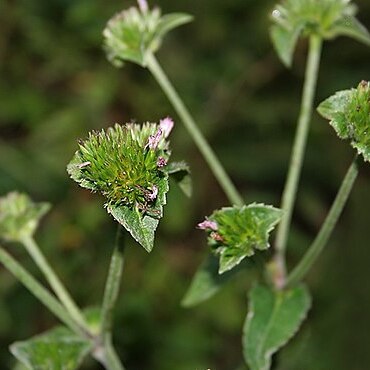Perennial herbs with annual stems from woody rootstocks; roots many, thong-like; indument of stiff hairs; stems branching in their distal part. Leaves alternate, the upper ones diminishing in size and grading into inflorescence bracts. Capitula homogamous, few-flowered, tightly packed into glomerules subtended by bracts; phyllaries few-seriate, ± cartilaginous with pungent apices. Corolla 5-lobed, more deeply cleft on one side.. Anthers sagittate.. Style branches linear, hairy. Achenes 10-ribbed, usually glandular between the ribs; pappus 1-seriate, the bases scale-like but rapidly tapering and barbellate bristle-like above.
Heads discoid, 1–5-fld, in glomerules subtended by 1–3 sessile, foliaceous bracts and resembling a single head; invol of 4 pairs of decussate bracts, the 2 outer pairs shorter, the alternate pairs conduplicate; fls all perfect and fertile, anthocyanic or sometimes white; receptacle flat or nearly so; cor unequally 5-cleft; style of Vernonia; pappus of 5–8 short, rigid, flattened scales prolonged at the summit (in our spp.) into a straight terminal bristle; perennial herbs with small glomerules of heads terminating the branches; our spp. fibrous-rooted and mostly single-stemmed. 30, mainly trop.
Achenes narrowly turbinate-cylindric, c. 10-ribbed, usually glandular between the ribs, setulose; pappus 1-seriate, setae 5–10 with bases broad scale-like and usually overlapping, gradually or abruptly tapering and subterete barbellate above.
Capitula homogamous, few-flowered, numerous, syncephalous in bracteate glomerules; glomerules terminal on stiff synflorescence branches, laxly corymbiform-cymose tending to be subscorpioid-cymose in arrangement.
Leaves alternate, often basal, sessile, or narrowly attenuate and petiole-like before widening into a ± stem-clasping, ± stem-sheathing base; upper leaves grading into leaf-like bracts.
Involucres narrowly ovoid-cylindric; phyllaries few-seriate, ± cartilaginous with pungent apices, strigose to densely hispid or glabrescent.
Vegetative indumentum sparse to dense, consisting of patent to appressed stiff bristle-like hairs.
Perennial ± hirsute herbs with annual stems from woody rootstocks; roots numerous, thong-like.
Corollas 5-lobed, asymmetric, more deeply cleft on one side.
Stems 1-several, leafy or scapiform, branching above.
Style arms linear-terete, hairy.
Anthers sagittate at the base.
Receptacle small, plane.

